2024 (January-December) Travel Trend Outlook
JTB Corp.
The number of inbound tourists is likely to hit record high at 33.1M.
●The number of Japanese domestic travelers is estimated at 273 million (97.2% of 2023 and 93.6% of 2019).
●The number of outbound travelers is estimated at 14.5 million (152.6% of 2023 and 72.2% of 2019).
●The number of international inbound tourists is estimated at 33.1 million (131.3% of 2023 and 103.8% of 2019).
JTB has compiled a report on a 2024 travel trend outlook. For 2021 and 2022 when COVID-19 had a significant impact, JTB released estimates for domestic trips only. JTB resumed releasing estimates for Japanese resident outbound trips and international inbound trips in 2023. The survey provides estimates on overnight or longer trips of Japanese residents travelling in Japan (including business trips and visits to hometowns) and of international visitors travelling to Japan. The estimates are made based on data such as economic indicators, consumer behavior surveys, transport/tourism related data, and surveys conducted by the JTB Group. The survey has been conducted continuously since 1981. The estimated size of the travel market in 2024 is as follows.
(Figure 1) 2024 Annual Travel Trend Estimates

*Domestic travel spend means total expenditures incurred after leaving home and until returning home. It includes spending at travel destinations such as shopping and meals and does not include spending before and after a trip (e.g., the cost of purchasing clothing or other travel goods).
*Outbound travel spend includes travel expenditures (including fuel surcharges) and spending at travel destinations such as shopping and meals. It does not include spending before and after a trip (e.g., the cost of purchasing clothing or other travel goods).
*For inbound trips, only the number of inbound tourists is estimated. Travel spend is not calculated.
*Figures at or below the second decimal point are rounded for comparisons with previous years and with 2019.
*The number of domestic travelers is the number of travelers going on an overnight or longer trip.
*The numbers of domestic travelers and outbound travelers both include those on business trips and visiting their hometown.
*Because the survey results are rounded, there could be discrepancies in the sub-totals or differences with previous years' figures.
<Social and Economic Trends and Environment Surrounding Traveling>
1.Situation of COVID-19 and travel trends before the end of 2023
The World Health Organization (WHO) announced in May 2023 the end of a global health emergency brought about by COVID-19 after more than three years had elapsed since they had declared COVID-19 as a worldwide pandemic in March 2020. While economic activities have mostly returned to their pre-COVID conditions worldwide, ongoing inflations and high interest rates caused by factors such as the rapid recovery in demand are having various impacts on people's lives. With respect to travelling, except for some countries and regions, international arrival and departure restrictions have generally been removed, enabling international travel in the same manner as in the pre-COVID period. According to the World Tourism Barometer released by the United Nations World Tourism Organization (UNWTO) in November 2023, the number of international tourists worldwide during the January-September 2023 period recovered to 87% of its pre-COVID level. Unstable international situations and the resulting rises in energy and other prices, however, are causing concerns. Furthermore, there are regional differences in recovery: the Asia Pacific region including Japan is recovering slower than Europe and the United States.
The Japanese government ended its border control measures in April 2023 and re-classified COVID-19 into Class-5, the same category as seasonal influenza, under the country's infectious disease laws in May 2023. These brought people's lives mostly back to pre-pandemic conditions. Regulatory restrictions on travelling have also been removed, and some regions are implementing a government-funded travel discount program as well as travel support measures of local governments. Partly due to these measures, tourism activities are returning nationwide, combined with a recovery in inbound tourism. Meanwhile, some tourist spots and areas are experiencing a service staff shortage and rising accommodation charges due to changes in the environment caused by the COVID-19 pandemic. In addition, there are concerns about overtourism.
2.Economic environment surrounding traveling and living conditions
The Nikkei Stock Average has remained over ¥30,000 since May 2023, demonstrating robust market activities in Japan. Meanwhile, the country's economic outlook remains uncertain due to the impact of global conditions and monetary policies of European countries and the United States. The World Economic Outlook released by the International Monetary Fund (IMF) in October 2023 forecasted Japan's growth rate in 2023 at 2.0%, which was above the actual growth rate of 1.0% recorded in 2022. The IMF, however, makes a grimmer forecast for 2024, expecting the 2024 growth rate to decline to 1.0%.
Looking at the current economic conditions, the trend of the rising US dollar against the Japanese yen accelerated in 2023 with a US dollar temporarily nearing the ¥152 mark on the FOREX market in November 2023. This has led to the ongoing rises in import prices, which are having a material impact on households (Figure 2). Looking at the consumer price index of major items, while electricity cost has relatively been stable thanks to the subsidies continuously provided by the Japanese government, prices of perishable foods, clothing, among others are rising and transport and communication costs are also steadily increasing (Figure 3). The prices of gasoline have also been kept down by the government subsidies, but they have constantly remained at around ¥170/liter (Figure 4). In this environment, looking at consumer sentiments, according to the current living conditions illustrated in a Bank of Japan survey on consumer sentiment, the ratio of respondents who are feeling a greater cost of living pressure has been consistently on the rise since September 2021, reaching 57.4% of all the respondents in September 2023, which is 21.1 percentage points (pp) higher compared with September 2021 (Figure 5). This shows that economic conditions remain difficult.
(Figure 2) 2023 FOREX Rates of Major Currencies Against Yen
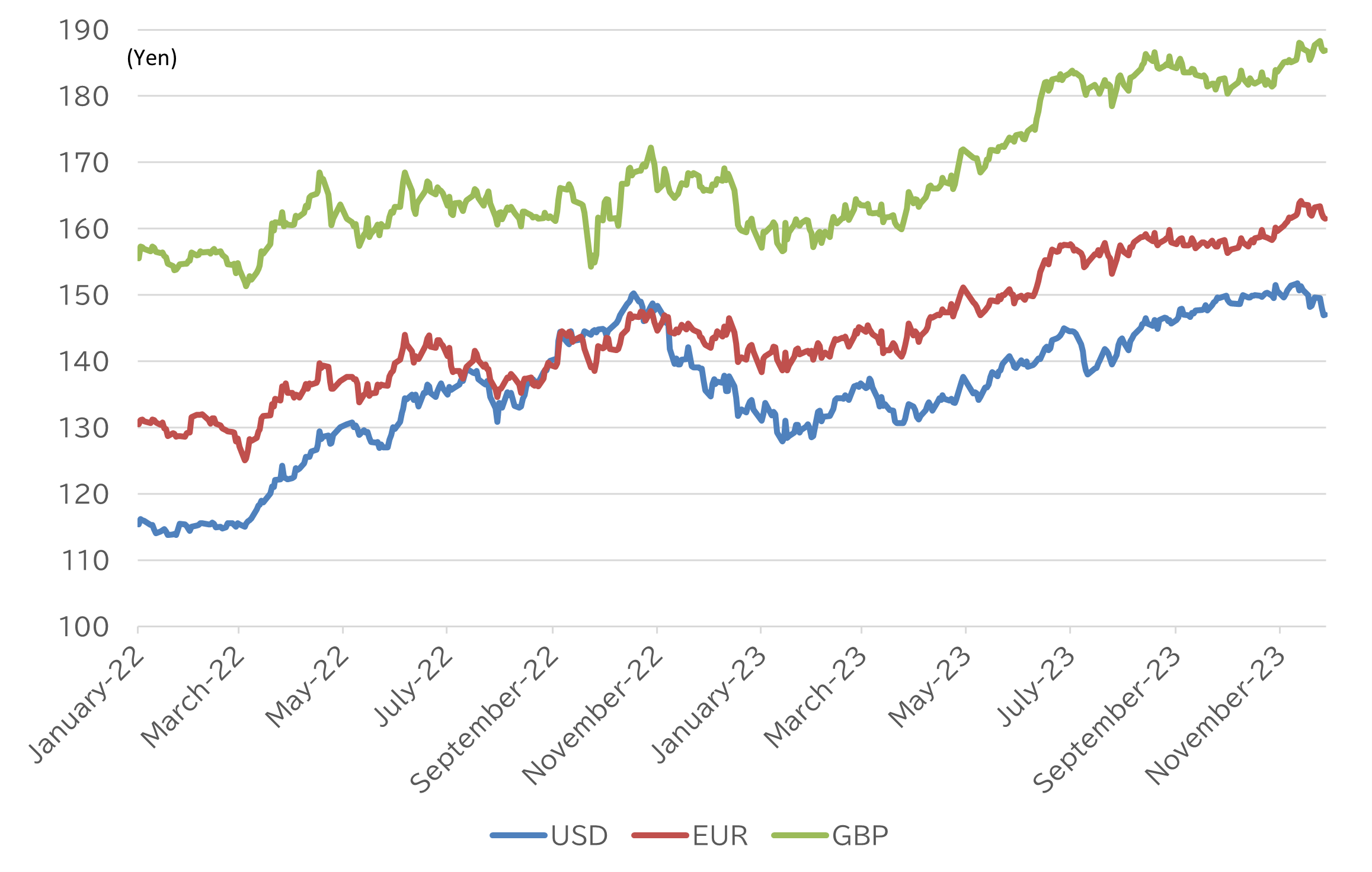
Source: Telegraphic Transfer Middle Rate (TTM) in the Tokyo FOREX market (FOREX data provided by Mitsubishi UFJ Research & Consulting Co., Ltd.)
(Figure 3) Consumer Price Index of Major Items

Source: Prepared by JTB Tourism Research & Consulting Co. based on consumer price index data (2020=100) provided by the Ministry of Internal Affairs and Communications, Japan
(Figure 4) Regular Gasoline Price
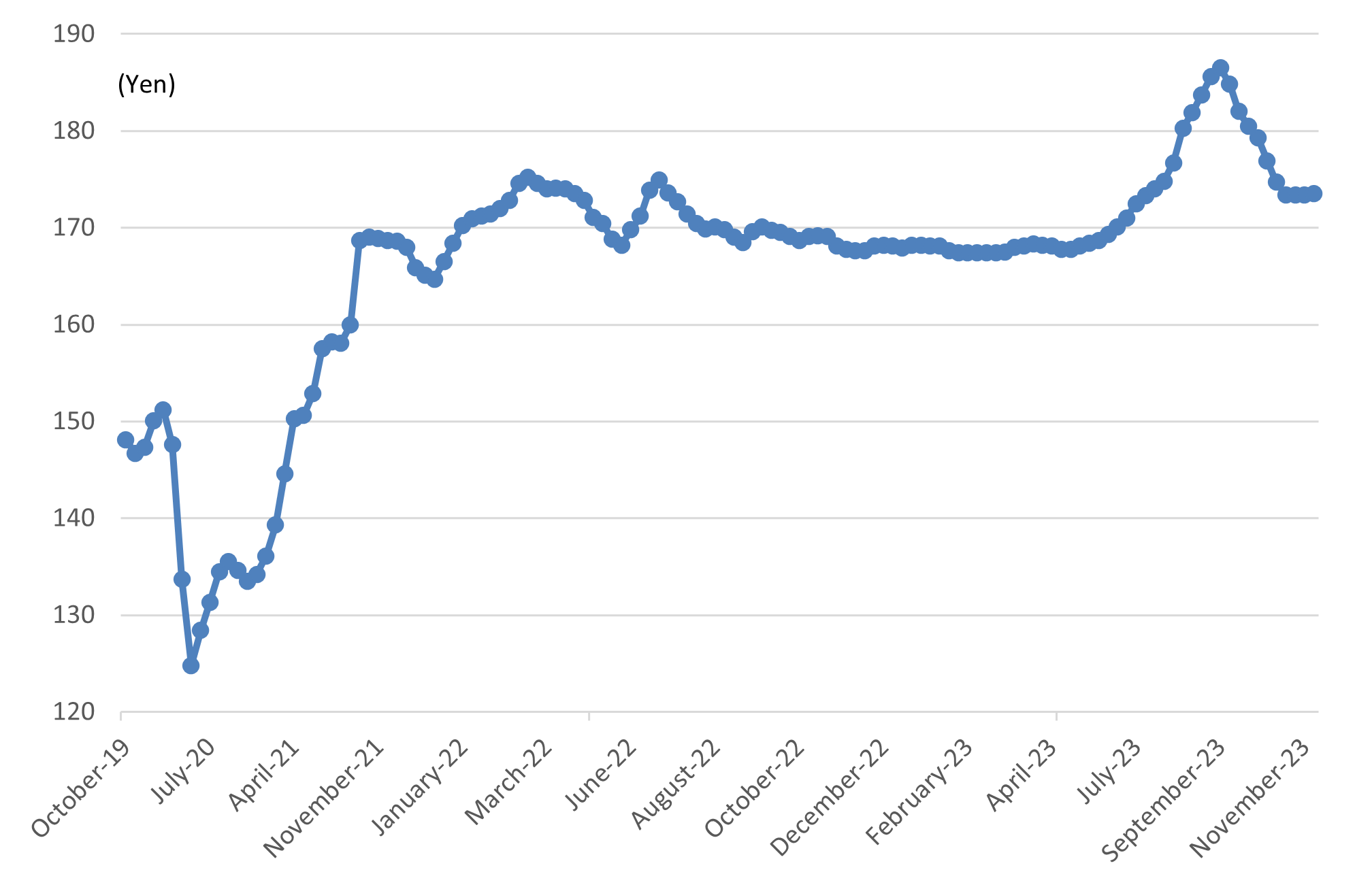
Source: Prepared by JTB Tourism Research & Consulting Co. based on a survey of petroleum product prices by the Agency for Natural Resources and Energy, Japan
(Figure 5) Current Living Conditions
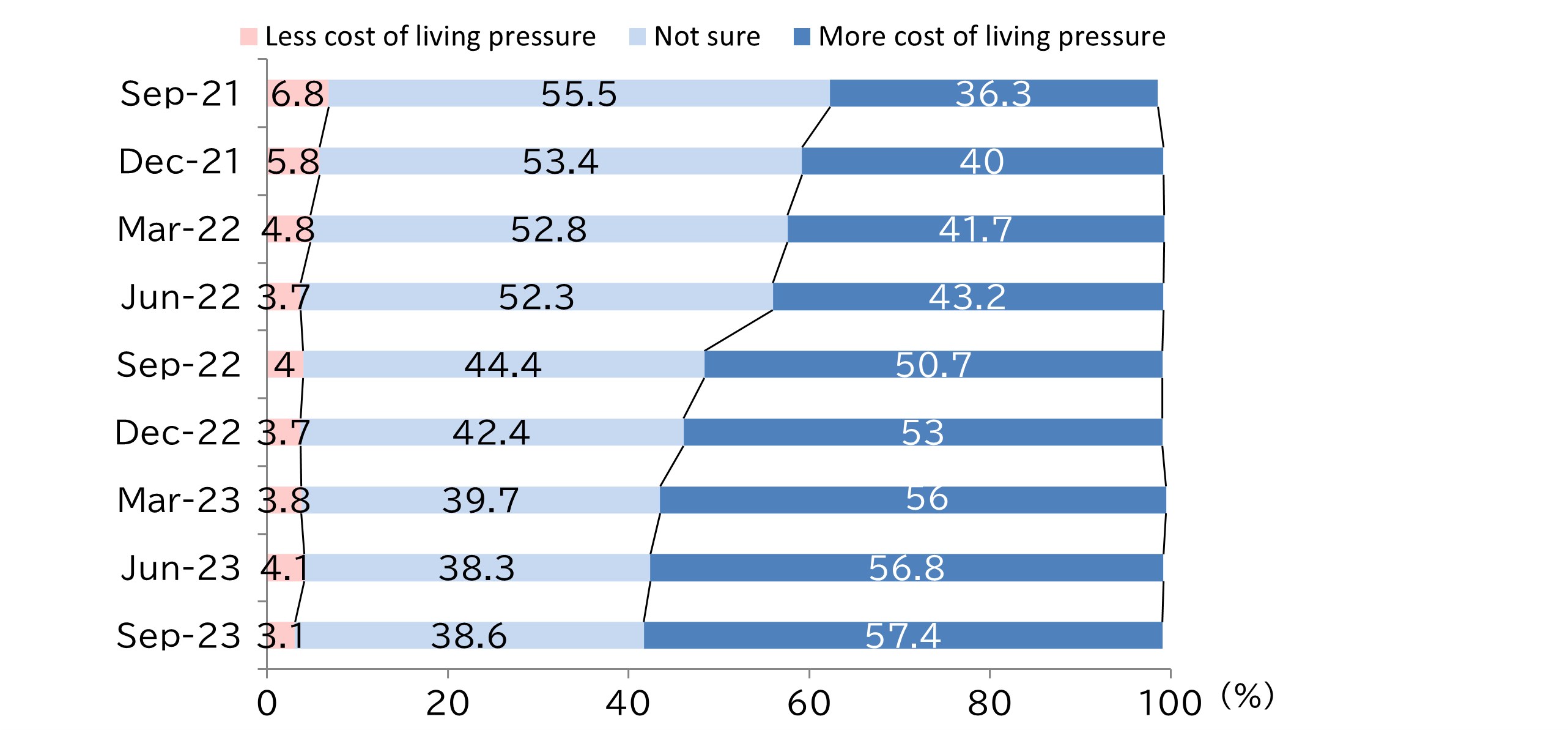
Source: Prepared by JTB Tourism Research & Consulting Co. based on data from the consumer sentiment surveys conducted by the Bank of Japan
3.Status of travelers
With respect to domestic travel, the number of visitor nights recovered to nearly its pre-COVID level in 2023 mainly because no COVID-related restrictions were placed on people's movements, the classification of COVID-19 was changed to Class-5 on May 8, and the Japanese government offered nationwide travel support subsidies. The total visitor nights in October 2023 were 41,333,000, representing 98.5% of the same figure in October 2022 (41,969,000) and 103.9% of the same month in 2019 (39,791,000). The cumulative total visitor nights from January to October 2023 stood at 398,765,000, representing 113.7% of the same period in 2022 (350,730,000) and 99.3% of the same period in 2019 (401,723,000) *1 (Figure 6).
*1: Source: Visitor nights statistic surveys by the Japan Tourism Agency; the first preliminary figure for October 2023, the second preliminary figure for January-September 2023, and definitive figures for 2019 and 2022.
After the Japanese government ended its border control measures on April 29, 2023, international travel has become easier in terms of national regulations. Recovery in outbound travelers, however, has been slow due to factors including inflations, the cheaper yen, and ongoing uncertainty in situations of certain areas. In October 2023, Japanese resident outbound departures stood at 938,000, representing 268.3% of the same figure in October 2022 (350,000 departures). The October 2023 figure, however, only represents 56.4% of the same figure in October 2019 (1,663,000 departures). The cumulative total for the January-October period was 7,649,000 departures, representing 390.2% of the same figure in the same period in 2022 (1,960,000 departures) and 45.7% of the same period in 2019 (16,726,000 departures) *2 (Figure 7).
*2: Numbers of inbound travelers to Japan and Japanese resident outbound departures provided by the Japan National Tourism Organization (JNTO); an estimate for October 2023, a provisional figure for January-September 2023, and definitive figures for October 2019 and October 2022.
Recovery in inbound tourism accelerated in 2023 due to factors such as the end of Japan's border control measures and the termination or relaxation of measures to combat COVID-19 worldwide. The number of inbound tourists to Japan in October 2023 was 2,517,000, representing 504.7% of the same figure in October 2022 (499,000) and 100.8% of the same figure in October 2019 (2,497,000), exceeding its pre-COVID level for the first time on a single-month basis. The cumulative total for the January-October period was 19,891,000, representing 1,302.3% of the same period in 2022 (1,527,000) and 73.9% of the same period in 2019 (26,914,000)*3 (Figure 7). By country and region, the largest number of inbound tourists to Japan during the January-October 2023 period came from South Korea (5,526,000; 107.7% of the same period in 2019), followed by Taiwan (3,399,000; 81.9% of the same period in 2019), and China (1,854,000; 22.8% of the same period in 2019) (Figure 8).
*3: Numbers of inbound travelers to Japan and Japanese resident outbound departures provided by the Japan National Tourism Organization (JNTO); estimates for September and October 2023, a provisional figure for January-August 2023, and definitive figures for 2019 and 2022.
(Figure 6) Cumulative Total Visitor Nights
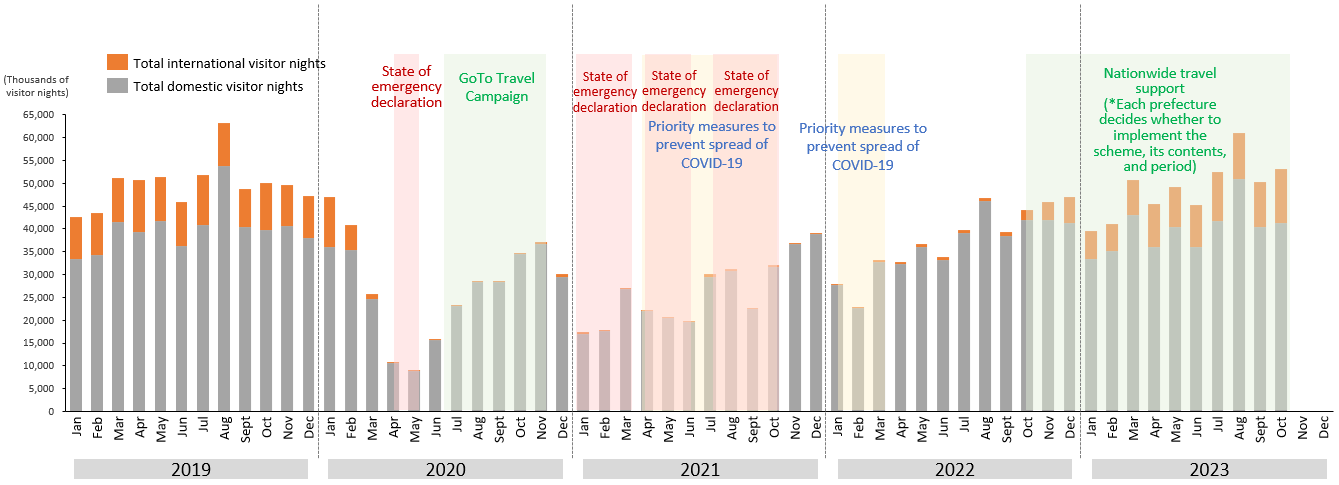
Source: Prepared by JTB Research & Consulting Co. based on visitor nights statistic surveys conducted by the Japan Tourism Agency; definitive figures for 2019 to 2022, the second preliminary figure for January-September 2023, and the first preliminary figure for October 2023).
(Figure 7) Total Visitor Nights, Japanese Resident Outbound Departures and International Inbound Tourists in October 2023 and January-October 2023 Period (Cumulative)

Source: Prepared by JTB Research & Consulting Co. based on visitor nights statistic surveys conducted by the Japan Tourism Agency and the numbers of inbound travelers to Japan and Japanese resident outbound departures provided by the Japan National Tourism Organization (JNTO).
(Figure 8) 2023 International Inbound Tourists by Country and Comparison with 2019 (Top 7 Countries)
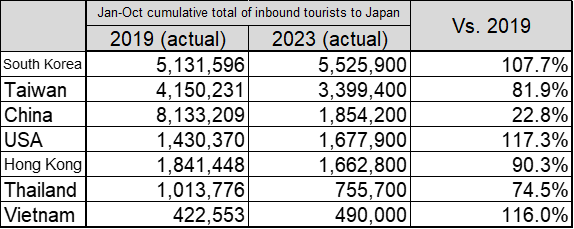
Source: Prepared by JTB Research & Consulting Co. based on the numbers of inbound travelers to Japan and Japanese resident outbound departures provided by the Japan National Tourism Organization (JNTO).
<2024 Travel Market>
4.2024 calendar and major events
There are 11 long weekends in 2024. It is a significant increase from 2023 which had seven long weekends. While the Golden Week holidays are split into the first long weekend (Saturday, April 27 to Monday, April 29) and the second long weekend (Friday, May 3 to Monday, May 6), it can become 10 consecutive holidays from Saturday, April 27 to Monday, May 6, if one takes time off work from Tuesday, April 30 to Thursday, May 2. In summer, if one takes time off work during the Obon festival period (Tuesday, August 13 to Friday, August 16), there will be nine consecutive holidays from Saturday, August 10 to Sunday, August 18. The 2024/25 year-end/new year period can be turned into nine consecutive holidays from Saturday, December 28 to Sunday, January 5, if one takes time off work on Monday, December 30 and Tuesday, December 31.
Jan. 6 (Sat) to Jan. 8 (Mon) (3 days)
Feb. 10 (Sat) to Feb. 12 (Mon) (3 days)
Feb. 23 (Fri) to Feb. 25 (Sun) (3 days)
Apr. 27 (Sat) to Apr. 29 (Mon) (3 days)
May 3 (Fri) to May 6 (Mon) (4 days)
Jul. 13 (Sat) to Jul. 15 (Mon) (3 days)
Aug. 10 (Sat) to Aug. 12 (Mon) (3 days)
Sept. 14 (Sat) to Sept. 16 (Mon) (3 days)
Sept. 21 (Sat) to Sept. 23 (Mon) (3 days)
Oct. 12 (Sat) to Oct. 14 (Mon) (3 days)
Nov. 2 (Sat) to Nov. 4 (Mon) (3 days)
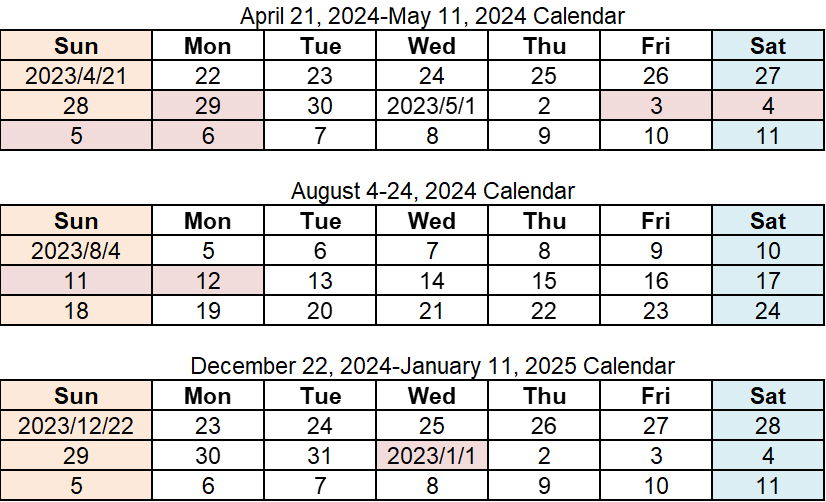
*The red letters indicate national holidays.
[1]The 33rd Olympics Games (Paris 2024 Summer Olympics) and Paris 2024 Paralympics Games
One of the notable events in 2024 is the 33rd Olympics Games (Paris 2024 Summer Olympics) and Paris 2024 Paralympics Games that will take place in France. The 33rd Olympics Games (Paris 2024 Summer Olympics) will start on Friday, July 26 and end on Sunday, August 11, while the Paris 2024 Paralympics Games is scheduled to start on Wednesday, August 28 and to end on Sunday, September 8. Both events will take place in multiple cities including Paris, while the surfing Olympics event will be held in Tahiti, a French territory.
[2]Extension of Hokuriku Shinkansen and opening of Kurobe-Unazuki Canyon Route in Japan
In Japan, the Kanazawa-Tsuruga section of Hokuriku Shinkansen is scheduled to start operating on Saturday, March 16. This reduces the travel time between Tokyo Station and Fukui Station to as short as two hours 51 minutes. In addition, in the Kurobe Canyon in Toyama Prefecture, the Kurobe-Unazuki Canyon Route that connects the Kurobe Dam and the Kurobe Gorge Railway Keyakidaira Station will be opened to the public on Sunday, June 30.
In addition, there are art events scheduled in 2024 such as the 8th Yokohama Triennale (Yokohama City, Kanagawa; Friday, March 15 to Sunday, June 9) and Echigo-Tsumari Art Triennale 2024 (Tokamachi City, Niigata; Saturday, July 13 to Sunday, November 10).
[3]Successive openings of new areas in popular theme parks and large commercial facilities
There are many scheduled openings of commercial facilities and launches of new contents in popular theme parks in 2024.
Universal Studio Japan plans to expand the Super Nintendo World™ area to 1.7 times the current size to open the Donkey Kong Country area featuring globally popular Donkey Kong. Meanwhile, Tokyo Disney Resort® plans to open a new theme port, Fantasy Springs, the eighth theme port in Tokyo DisneySea, on Thursday, June 6. The new port will consist of three areas themed after Frozen, Rapunzel, and Peter Pan and a new Disney Hotel, Tokyo DisneySea Fantasy Springs Hotel.
Regarding commercial facilities, as part of the redevelopment project around Osaka Station in Osaka City (Osaka), the Umekita 2nd Project "Grand Green Osaka," some facilities including a park, hotel, and commercial facilities will start operating in September ahead of others. In Nagoya City (Aichi), the Chunichi Building, which closed in 2019 due to ageing, has been rebuilt and is scheduled to open in spring. In Matsuyama City (Ehime), Dogo Onsen Honkan, which has been operating partially for conservation and repair works since 2019, will begin operating in full in mid-July for the first time in five years (conservation and repair works are scheduled to be fully completed in December).
[4]Lively activities for accommodation facilities; many new openings including openings of all the Mercure Hotels in Japan
New accommodation facilities are also scheduled to open successively. Daiwa Resort Co., Ltd. has rebranded 23 existing Daiwa Royal Hotels into 12 Grand Mercure hotels, the first group of Mercure hotels in Japan, and 11 Mercure hotels. All the hotels will start operating on April 1.
In the Kansai area, Banyan Tree Higashiyama Kyoto, the flagship brand of Banyan Tree Hotels & Resorts headquartered in Singapore, is scheduled to open in Kyoto City (Kyoto) in spring, while the Osaka Station Hotel is scheduled to open in Osaka City (Osaka) inside KITTE Osaka. which is scheduled to open in July (Figure 9).
(Figure 9) Main Facilities Scheduled to Open in 2024

5.Domestic travel trends *Domestic trips of residents of Japan excluding international inbound tourists
The number of domestic travelers in 2024 is projected at 273 million (97.2% of 2023 and 93.6% of 2019).
The average spend is estimated at ¥43,200 (100.0% of 2023 and 113.4% of 2019).
Total domestic travel spend is forecast at ¥11,790 billion (97.1% of 2023 and 106.0%of 2019).
In 2024, the number of domestic travelers is estimated at 273 million (97.2% of the same figure in 2023 and 93.6% of 2019), average spend at ¥43,200 (100.0% of the same figure in 2023 and 113.4% of 2019) due to the expected continuation of high prices, and total domestic travel spend at ¥11,790 billion (97.1% of the same figure in 2023 and 106.0% of 2019). Although the classification of COVID-19 was changed to Class-5 in May 2023 and its impacts were mostly eliminated, the number of travelers is likely to plateau due to factors such as high travel expenditures and the easing of travel appetite (as spending in reaction to the reduced activities during the COVID-19 pandemic will run its course). In 2024, the living environment is anticipated to remain difficult due to the ongoing inflation, while there are expectations for the Japanese government's economic policy.
In the 2023/24 year-end/new year travel trend survey (December 23, 2023-January 3, 2024) conducted by JTB, on a question about future domestic travel plans by destination, "Places abundant with nature" ranked first as a place that the respondents "Want to go immediately" with 30.2% of the respondents choosing this option, followed by "Neighboring prefectures that are accessible using public transport, own car, rental car, etc." at 29.1%. This shows a trend of choosing places with nature and nearby places as travel destinations (Figure 10).
Due to COVID-19, climate change, uncertain international situations, and so on, lifestyles and values have changed worldwide, which is affecting Japanese residents' domestic travel preferences and tourist spots in Japan.
Promotion of travel/hospitality operators' and local communities' initiatives with awareness of SDGs
Travel companies are promoting various initiatives aiming to contribute to Sustainable Development Goals (SDGs) and sustainability. For instance, these include tours and events designed to reduce CO2 emissions, the protection, development, and exchange of traditional local cultures and arts, and the use of natural resources for tourism. Airline carriers are also working on reducing their CO2 emissions through efforts such as the introduction of sustainable aviation fuel (SAF).
Meanwhile, tourism destinations have begun initiatives to build sustainable tourism spots. For instance, 10 places in Japan were selected in the 2023 Top 100 Stories chosen by Green Destinations, a certification organization for international indices for sustainable tourism developed by the Global Sustainable Tourism Council (GSTC). The Japan Tourism Agency has been promoting the sustainable management of tourism places since the establishment of the Japan Sustainable Tourism Standard for Destinations (JSTS-D) in June 2020.
Nationwide promotion of measures to prevent overtourism
Since the end of the COVID-19 pandemic, some tourist places are facing an issue of overtourism brought about by a recovery in travel demand. In response, the Japanese government prepared a policy package for measures against overtourism and is scheduled to select approximately 20 places for its pilot projects. The government's support may include the dissemination of real-time crowd information of tourist spots to disperse visitors from overcrowded destinations and the introduction of a shared-taxi ride service.
Meanwhile, some tourist places have already started implementing measures to tackle overtourism. For instance, in Kyoto, visiting hours of temples and other tourist attractions have been extended to the early morning and nighttime to spread visitors and efforts are made to reduce congestion by displaying crowd situations on apps or transmitting real-time images of tourist destinations using installed cameras.
(Figure 10) Future Domestic Travel Intensions by Destination Type
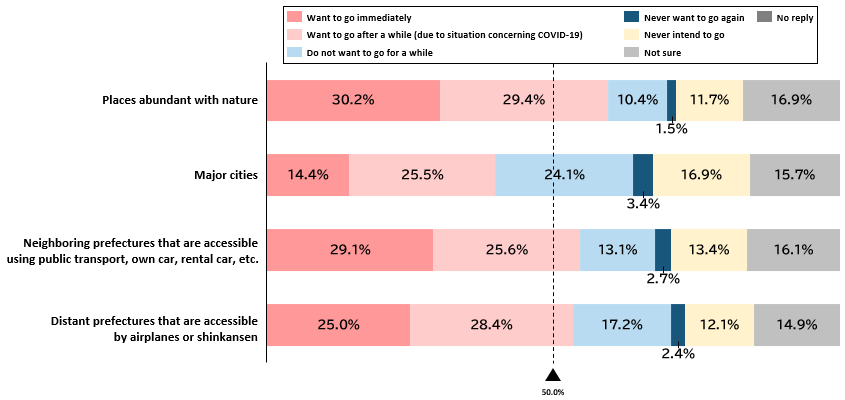
Source: Prepared using the unpublished data of JTB's 2023/24 year-end/new year travel trend survey (December 3, 2023-January 3, 2024).
6.International travel trends
The number of outbound travelers in 2024 is estimated at 14.5 million (152.6% of 2023 and 72.2% of 2019).
The average spend is projected at ¥342,100 (105.5%t of 2023 and 144.2% of 2019).
Total outbound travel spend is estimated at ¥4,960 billion (161.0% of 2023 and 104.0% of 2019).
In 2024, the number of outbound travelers is estimated at 14.5 million (152.6% of the same figure in 2023 and 72.2% of 2019), average spend at ¥342,100 (105.5% of the same figure in 2023 and 144.2% of 2019) due to the continuing impact of the cheaper yen and overseas inflations, and total outbound travel spend at ¥4,960 billion (161.0% of the same figure in 2023 and 104.0% of 2019). While international travel has become easier in terms of national regulations after the termination of Japan's border control measures in April 2023, the number of outbound travelers in 2024 is expected to recover slowly due to factors such as uncertain international situations, in addition to economic factors. As a result, the number is not expected to recover to its pre-COVID level at least until 2025. The average spend per person is projected to exceed the previous year and reach the highest since 2000.
In the 2023/24 year-end/new year travel trend survey (December 23, 2023-January 3, 2024) conducted by JTB, Hawaii ranked highest at 14.3% among the destinations the respondents wanted to go immediately, in response to a question on future outbound travel plans. This was followed by "Europe (12.7%)," "Australia/New Zealand (11.8%)," "Taiwan (10.9%)," "USA (mainland) (10.0%)," "South Korea (9.6%)," and "Guam/Saipan (9.1%)." Relatively distant countries/regions ranked higher, followed by relatively closer countries/regions, showing a clear trend of division between close and distant destinations (Figure 11). With respect to the respondents' current international travel intentions, although they are positive about travelling overseas, economic and other factors are posing obstacles (Figure 12).
(Figure 11) Future International Travel Intensions by Destination
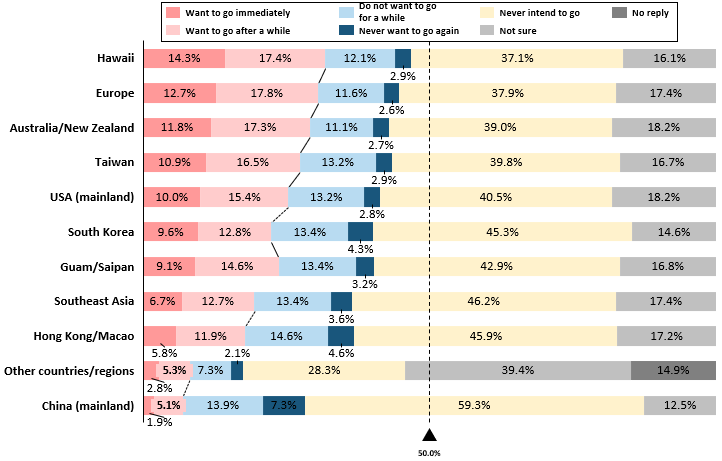
(Figure 12) Current International Travel Intensions
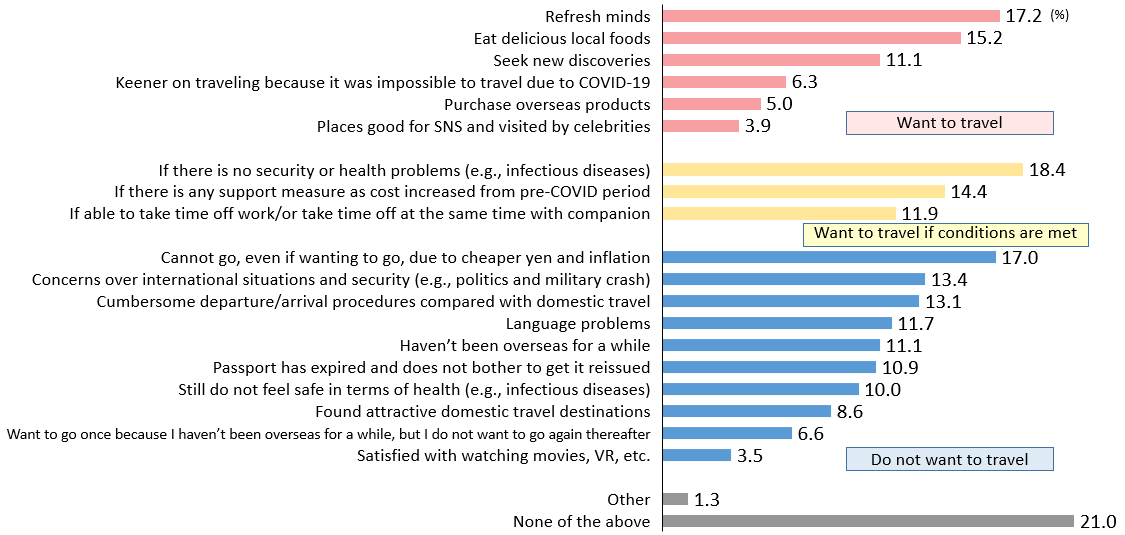
Source: 2023/24 Year-end/new year travel trend survey (December 23, 2023-January 3, 2024) by JTB
7.Number of inbound travelers to Japan
The estimated number of inbound travelers to Japan in 2024 is 33.1 million (131.3% of 2023 and 103.8% of 2019).
The number of inbound travelers to Japan in 2024 is estimated at 33.1 million (131.3% of the same figure in 2023 and 103.8% of 2019). The number of inbound tourists is rapidly recovering due to the increased ease to travel to Japan from overseas following the end of Japan's border control measures in April 2023 and a sense of better value for money spent due to the cheaper Japanese yen and relatively low prices compared with Europe, the United States, and other areas. By country and region, the numbers of visitors from South Korea, Taiwan, the United States, and Hong Kong have already exceeded or recovered close to their pre-COVID levels. Inbound visitors from these places are expected to further increase in 2024 and to reach a record high exceeding the 2019 level. Although recovery in the number of visitors from China has been significantly slower than other countries/regions, the number is steadily increasing, albeit slowly, and is expected to further recover in 2024, especially those travelling as individuals.
According to the Development Bank of Japan (DBJ) and Japan Travel Bureau Foundation (JTBF) 2023 survey of inbound visitors to Japan from Asia, Europe, the United States, and Australia, released by DBJ and JTBF in October 2023*4, Japan ranked first, as in the previous year, as the country/region the respondents wanted to travel next, showing strong popularity of Japan as a travel destination (Figure 13). In addition, there is a strong interest in visiting regional areas in Japan (among those wishing to visit Japan and those who have visited Japan), raising expectations for the spread of inbound visitors to regional communities as promoted by the Japanese government (Figure 14).
*4: A survey of male/female respondents aged 20-79 who have travelled overseas and live in 12 countries/regions including Asia, Europe, USA, and Australia (South Korea, China, Taiwan, Hong Kong, Thailand, Singapore, Malaysia, Indonesia, USA, Australia, UK, France).
(Figure 13) Countries/Regions Respondents Want to Visit Next (n = 7,414; allowed to choose up to 5 destinations; top 20 countries/regions)
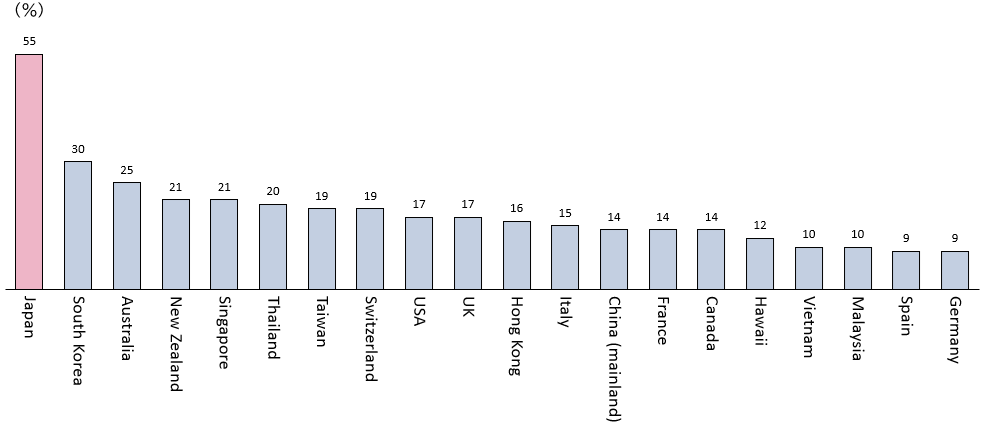
Source: Prepared by JTB Research & Consulting Co. based on the DBJ/JTBF 2023 survey of inbound visitors to Japan from Asia, Europe, the United States, and Australia conducted by the Development Bank of Japan (DBJ) and Japan Travel Bureau Foundation (JTBF).
*The countries/regions where the respondents are from and their neighboring countries/regions (China/Hong Kong/Macao, Malaysia/Singapore, Thailand/Malaysia, USA/Canada/Mexico, Hawaii/Guam, Australia/New Zealand, UK/France/other European countries) were removed from the options for the countries/regions to visit next. When calculating percentages, if the "country/region respondents want to visit" and "the respondents' country/region" and "the respondents' neighboring countries/regions" are same, those respondents are removed from the number of samples (denominator).
(Figure 14) Interest in Regional Communities Among People Wishing to Travel to Japan and People Who Have Traveled to Japan (n = 2,244; single answer)
(The percentages of people who have responded that they are "Very keen to travel in the future" or "Keen to travel in the future if there is an opportunity")

Source: Prepared by JTB Research & Consulting Co. based on the DBJ/JTBF 2023 survey of inbound visitors to Japan from Asia, Europe, the United States, and Australia conducted by the Development Bank of Japan (DBJ) and Japan Travel Bureau Foundation (JTBF).
(Figure 15) 2000-2022 Estimates and 2023-2024 Forecasts (The figures in the lower row show year-on-year percentage changes)
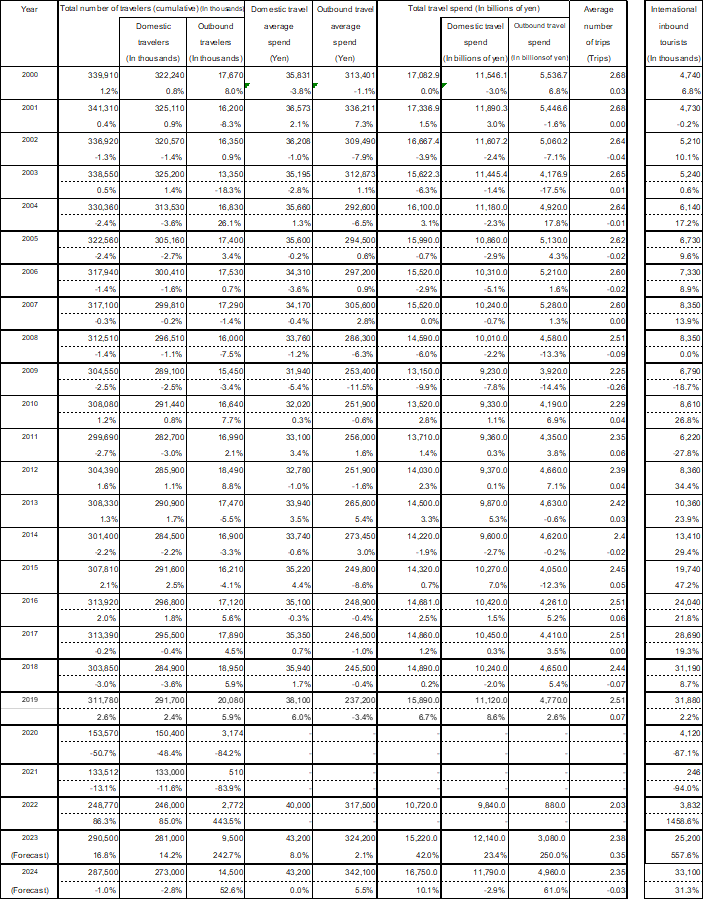
JTB Corp. Branding & Communication Team (Public Relations)
Phone: +81 3 5796 5833
